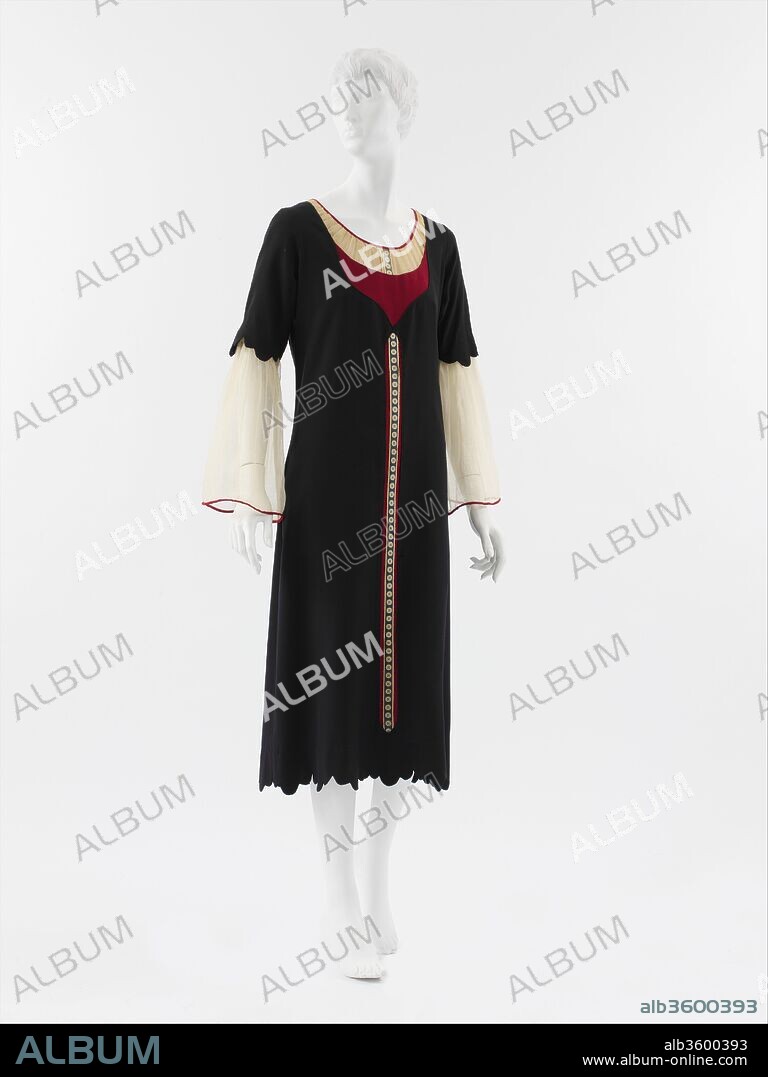alb3600393
PAUL POIRET. DRESS

|
Zu einem anderen Lightbox hinzufügen |
|
Zu einem anderen Lightbox hinzufügen |



Haben Sie bereits ein Konto? Anmelden
Sie haben kein Konto? Registrieren
Dieses Bild kaufen

Autor:
Titel:
DRESS
Untertitel:
Automatische Übersetzung: Kleid. Kultur: Französisch. Designer: Paul Poiret (Französisch, Paris 1879-1944 Paris). Datum: 1925. Aufgrund ihrer kräftigen Farbgebung, der reichen Detaillierung, der dramatischen (wenn auch einfachen) Silhouetten und der sofort erkennbaren Referenzen repräsentierten die Designs von Poiret im orientalistischen Stil die stärkste Identität seines Hauses. Tatsächlich waren Poirets Sammlungen eine Verschmelzung all seiner Interessen. Anstelle eines einheitlichen Themas boten seine Präsentationen den Kunden eine Reihe von Silhouetten und stilistischen Effekten. Viele Entwürfe zitierten Herrenbekleidung, Sportbekleidung (etwas, das Poiret schließlich als unangemessenen Stil für die Haute Couture zurückweisen würde) und historische Stile, insbesondere solche aus der Antike, dem Mittelalter, der Renaissance und dem Zweiten Kaiserreich, in einer berauschenden eklektischen Mischung. Obwohl ?Bouclier? eine andere Periode oder Kultur auszuschließen scheint, die seine Inspiration gewesen sein könnte, offenbart sich Poirets informierter Historismus im Trompe-l'oeil-Detail einer schmalen Knopfleiste, die mit einem Knopfmotiv bedruckt ist, das auf die geknöpften Latzkleider der 1880er Jahre verweist . Der Effekt ist eine Illusion einer durchsichtigen Baumwollbluse oder eines Chemise unter einem roten Kleid mit einem marineblauen Überkleid. Während seine Designmerkmale hauptsächlich frontal sind, fügte Poiret dem hinteren Ausschnitt eine dekorative Schleife hinzu, die seinen verspielten Geist verstärkt. Durch seine Farbpalette und seine Assoziation mit dem schicken Stil junger Pariserinnen spielt das Kleid auf die französische nationale Identität an. Es war in Art-Goût-Beauté mit einem anderen Modell namens "École" vertreten, das ebenfalls in Blau, Weiß und Rot gerendert wurde. Beide Kleider wurden mit passenden Accessoires kombiniert, um ihre nationalistischen Obertöne zu unterstreichen. Poiret war ein erbitterter Patriot, obwohl er während des Ersten Weltkriegs wegen seines Boche-Geschmacks wegen eines Cartoons in der deutschen Comic-Zeitung Simplicissimus kritisiert wurde, in dem eine deutsche Hausfrau von ihrem Soldaten-Ehemann versichert wurde, dass sie bald ein neues Poiret-Kleid bekommen würde. In der Tat waren für Poiret Orientalismus und Klassizismus, die im Diskurs der Moderne oft als rivalisierende ästhetische Modelle angesehen wurden, sich gegenseitig verstärkende Ausdrucksformen seines Patriotismus, so tief verwurzelt waren sie in der Kulturpolitik Frankreichs.
Dress. Culture: French. Designer: Paul Poiret (French, Paris 1879-1944 Paris). Date: 1925.
Because of their bold coloring, rich detailing, dramatic (if simple) silhouettes, and immediately recognizable references, designs by Poiret in the orientalist mode came to represent the strongest identity of his house. In fact, Poiret's collections were an amalgamation of all his interests. Rather than one unified theme, his presentations offered clients a range of silhouettes and stylistic effects. Many designs cited menswear, sportswear (something Poiret would eventually repudiate as an inappropriate style for the haute couture), and historical styles, especially those from antiquity, the Middle Ages, the Renaissance, and the Second Empire, in a heady eclectic mix.
Although 'Bouclier' appears to preclude another period or culture that might have been its inspiration, Poiret's informed historicism reveals itself in the trompe l'oeil detail of narrow placket printed with a button motif, which references the button-down pinafore dresses of the 1880s. The effect is of an illusion of a sheer cotton blouse or chemise under a red dress with a navy overdress. While its design features are primarily frontal, Poiret added a decorative bow to the back neckline, reinforcing its playful spirit.
Through its color palette and its association with the chic style of young Parisiennes, the dress alludes to French national identity. It was represented in Art-Goût-Beauté with another model called 'École,' also rendered in blue, white, and red. Both dresses were paired with matching accessories to underscore their nationalistic overtones. Poiret was a fierce patriot despite having been criticized during World War I for his boche taste because of a cartoon in the German comic paper Simplicissimus that featured a German housewife being assured by her soldier husband that she would soon get a new Poiret dress. Indeed, for Poiret, orientalism and classicism, often seen as rival aesthetic models in the discourse of modernism, were mutually reinforcing expressions of his patriotism, so deep-rooted were they in the cultural politics of France.
Technik/Material:
wool, silk
Museum:
Metropolitan Museum of Art, New York, USA
Bildnachweis:
Album / Metropolitan Museum of Art, NY
Freigaben (Releases):
Model: Nein - Eigentum: Nein
Rechtefragen?
Rechtefragen?
Bildgröße:
3170 x 4226 px | 38.3 MB
Druckgröße:
26.8 x 35.8 cm | 10.6 x 14.1 in (300 dpi)
Schlüsselwörter:
 Pinterest
Pinterest Twitter
Twitter Facebook
Facebook Link kopieren
Link kopieren Email
Email
